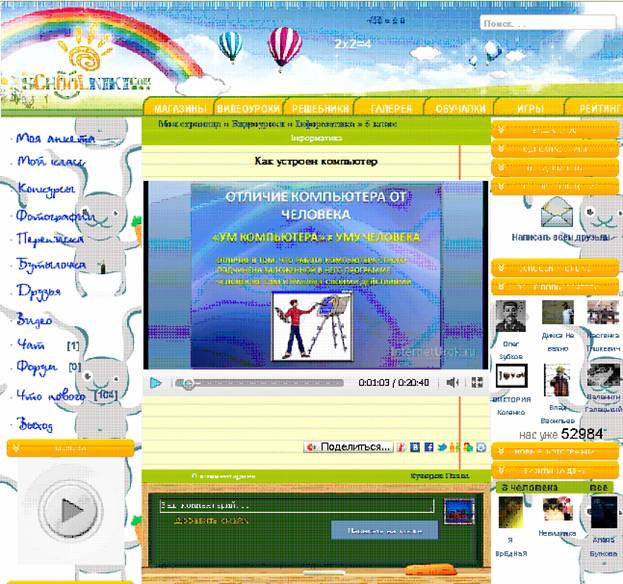DonNTU => Masters' portal
 Resume
Abstract
Resume
Abstract
|
AbstractIntroduction1. Review of existing social networks for schoolchildren 2. Results of development Conclusions References IntroductionCurrently, there are rapid increases in activity of young people in social networks, which become one of the main signs of time. In teaching science, this phenomenon has been debated and studied, is an active search for ways to use social networks for the purposes of education and youth development.Researchers believe that the using of digital technology is the basis for the implementation personalizing education opportunities and space for cooperation [1]. They argue that the using of digital technology will allow students to learn together, collaborate and accumulate knowledge, which includes personal information, including full name, age, school location and students, and their pictures. On the one hand, concerns of adults are growing about security and privacy of young people because of children and young people become the authors of blogs in which they can post personal information. 1. Review of existing social networks for schoolchildren1.1 «Дневник.ру»This is a unique Internet project, the main aims of this project are creating a single educational network for all participants in the educational process. Logo can be seen in Figure 1.1. Developing was started in 2007 and it was launched in 2009. Now it connects to over 8,000 schools and 700,000 students of RF. "Diary" is a closed network. If you have access code you will be able to sign up.  Figure 1.1 - Logo examined social network «Дневник.ру» 1.2 «webiki.ru» Social network game for primary school children; 1.3 «tvidi.ru» The goal of developers of social networking was creating a unique and positive environment for development of school age children. After registration in the social network Tvidi.ru, a child can play online games, post photos and videos and communicate with their peers from all over the world; 1.4 «kinder-online.ru» "It was designed for girls and boys from 10 to 16 years. You can find a lot of friends. The pride of our site is a children's chat, which in a short time brought very friendly users not only from Russia but from all CIS countries. Children's chat portal offers a wide range of games online, children can take part in quizzes and competitions. We offer to visit our children's forum or create their first children's Blog. " 1.5 «classnet.ru» "Social Network for Russian students brings together students of different schools from different cities. It allows finding friends with same interest. When you create your classes and add the most interesting moments of school life, photography and video, student will be informed of school events!"; 1.6 «webkinz.com» The global social network for children is marked by the absence User Generated Content. «For communication children should use ready phrases in site. Because of this idea unwanted content for children has zero chance "- say the creators of the network Logos examined social networks are presented in Figure 1.2.  Figure 1.2 – Logos examined social networks. It should be noted that all these social networks are designed for students of Russia and Ukraine has no analogues. Unfortunately, Ukraine is not a pioneer in Internet technology, so many projects will come to Ukraine after its were introduced abroad. 2. Results of developmentPProject development was beginning in first part of 2011. And it continues to the present time (05/17/2012). During the first six months of development have been implemented all tasks, the project was launched to a wider audience and over the next six months promotion came more than 50,000 registered users. In Figure 2.1 you can see animated header.Figure 2.1 - Animated header This project is interested not only users but and other companies of neighboring subjects. For example project "Internet lesson" offered cooperation and have provided all educational video content.  Figure 2.2 - Interface site In the summer of 2012 we are going to translate the site on English, to add an API for application development by third-part developers. After completion of the innovations will attract English-speaking audience. ConclusionsThe much of functionality of our school social network isn’t different from existing school social networks in Russia. The first step of developing social network is the most difficult stage in the project. And the most important step is collecting the first area of target audience, that will not only active on the site, but will bring their ideas, participate in the site life and recommend to their friends.References[1] Martin Owen, Lyndsay Grant, Steve Sayers and Keri Facer. Social software and learning, Futurelab, July 2006; [2] Розина И.Н.. Виртуальные исследовательские сообщества: от зарубежных моделей к отечественным примерам. - Educational Technology & Society, 12(2), 2009, ISSN 1436-4522, pp. 389-408; [3] Голицына И.Н. "Социальные сети как средство развития интеллектуального потенциала пользователей" [Электронный ресурс]. [4] Губанов Д.А., Новиков Д.А., Чхартишвили А.Г. "Социальные сети: модели информационного влияния, управления, противоборства", Москва, Физматлит, 2010; [5] Роберт П. Липшуц, «Серверы Web», СК Пресс 4S/96 PC Magazine, September 10, 1996, p.16; [6] Езерский C., Web-сервер на Debian GNU/Linux; [7] Детские социальные сети [Электронный ресурс]. NoteThe master's work is not yet complete. Finally, completion: December 2012. The full text of the work and materials on the topic can be obtained from the author or his head after that date.
|
|
Resume Abstract |
